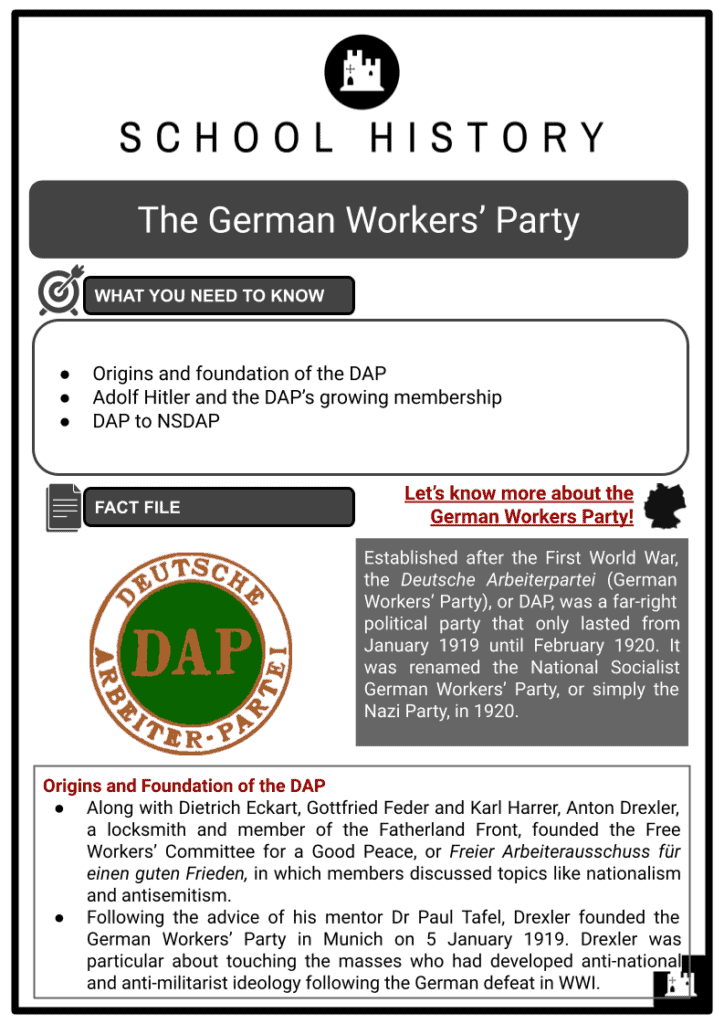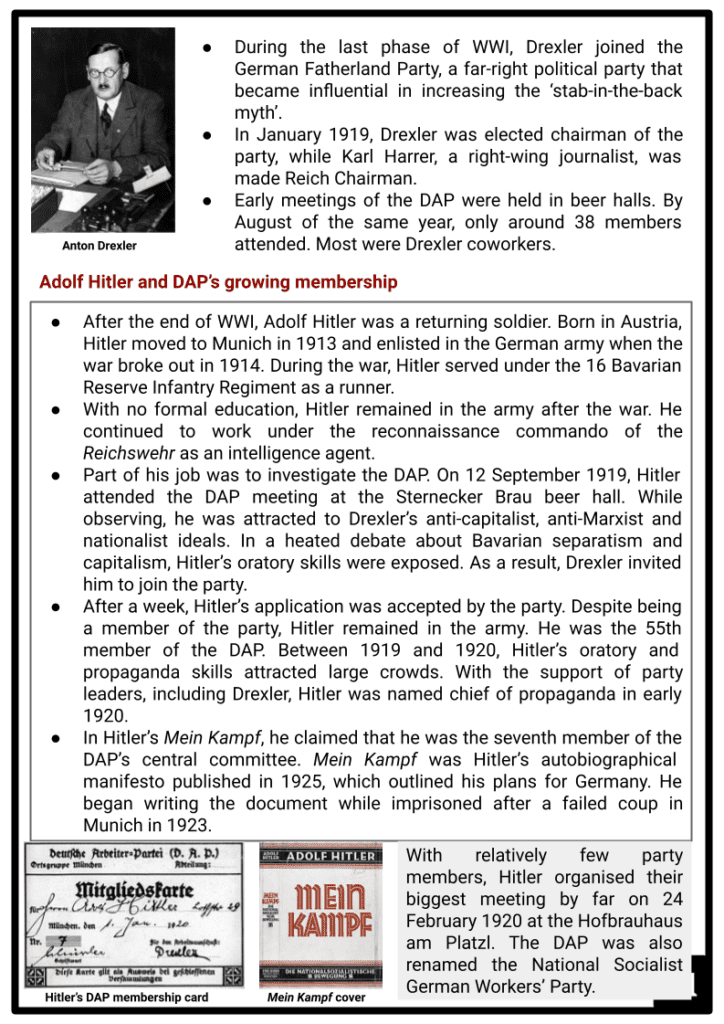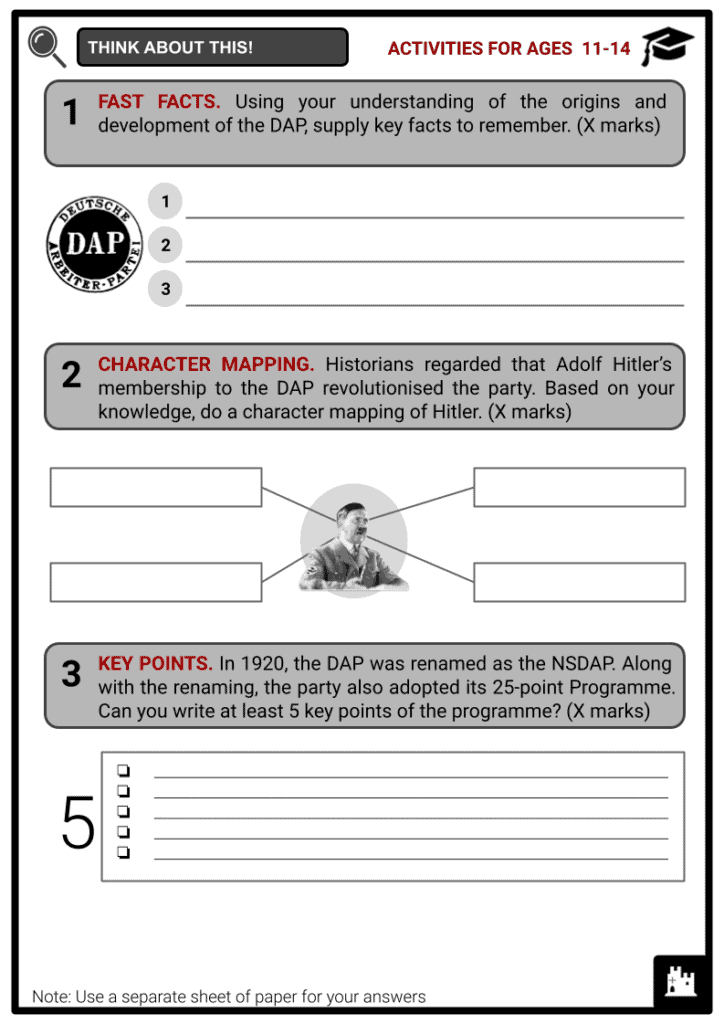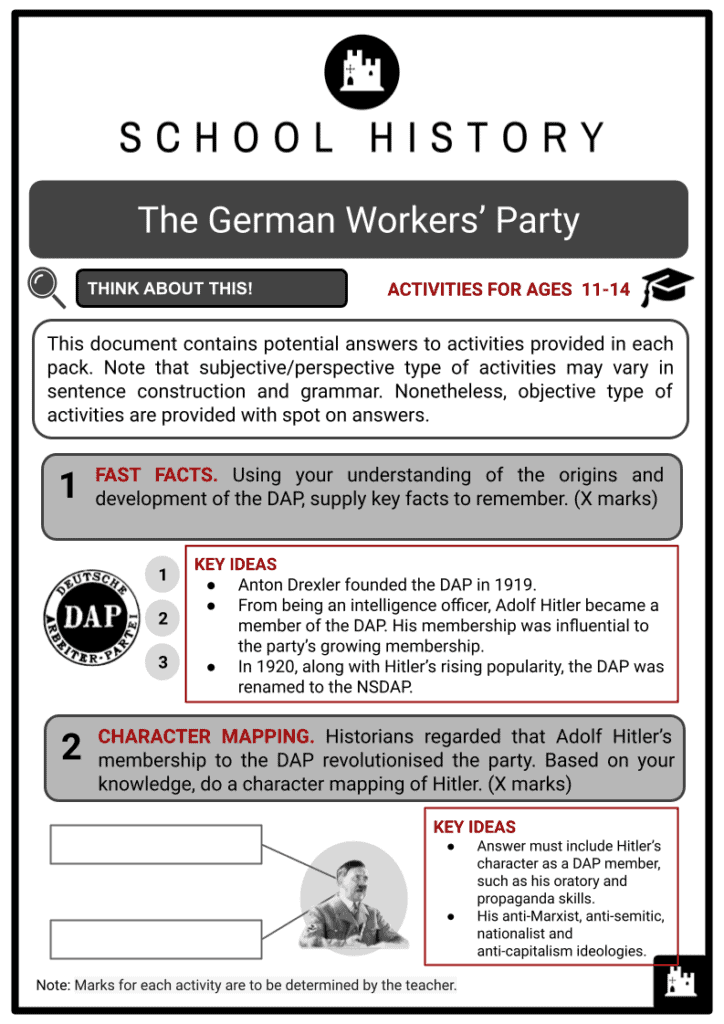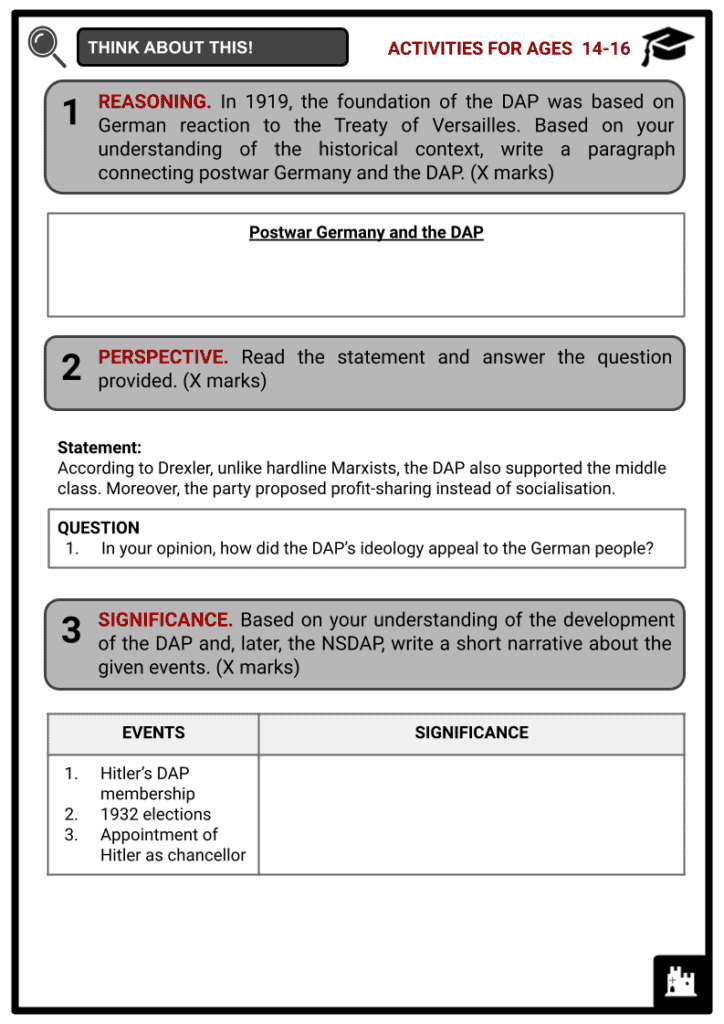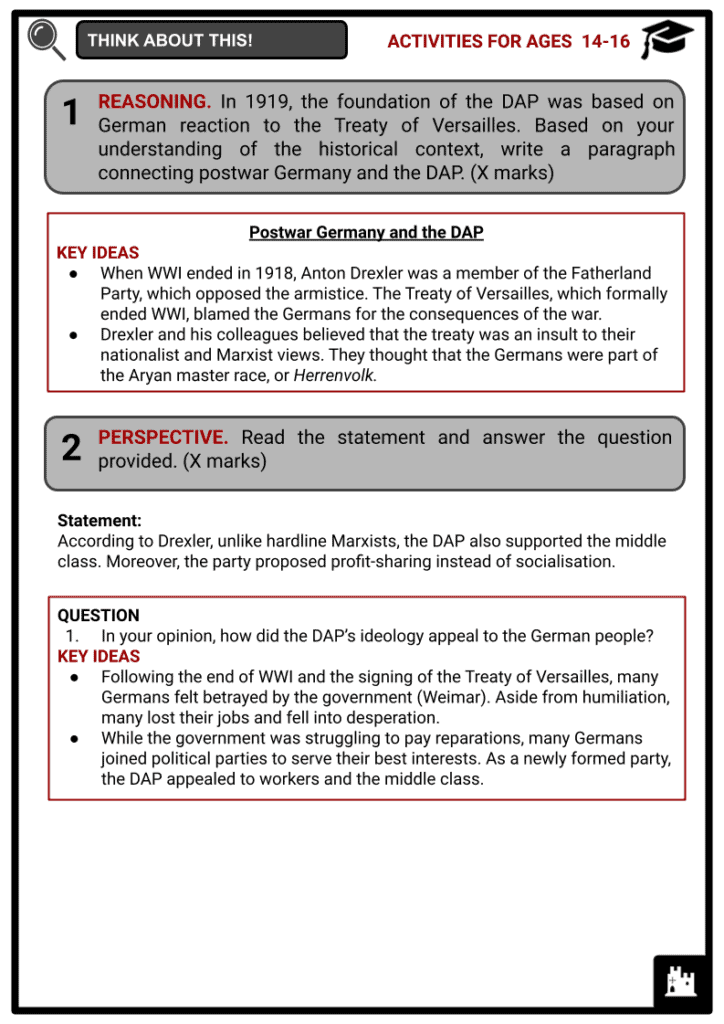Download The German Workers' Party Worksheets
Do you want to save dozens of hours in time? Get your evenings and weekends back? Be able to teach about the German Workers' Party to your students?
Our worksheet bundle includes a fact file and printable worksheets and student activities. Perfect for both the classroom and homeschooling!
Table of Contents
Add a header to begin generating the table of contents
Summary
- Origins and foundation of the DAP
- Adolf Hitler and the DAP’s growing membership
- DAP to NSDAP
Key Facts And Information
Let’s find out more about the German Workers' Party!
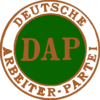
Established after the First World War, the Deutsche Arbeiterpartei (German Workers’ Party), or DAP, was a far-right political party that only lasted from January 1919 until February 1920. It was renamed the National Socialist German Workers’ Party, or simply the Nazi Party, in 1920.
Origins and Foundations of the DAP
- Along with Dietrich Eckart, Gottfried Feder and Karl Harrer, Anton Drexler, a locksmith and member of the Fatherland Front, founded the Free Workers’ Committee for a Good Peace, or Freier Arbeiterausschuss für einen guten Frieden, in which members discussed topics like nationalism and antisemitism.
- Following the advice of his mentor Dr Paul Tafel, Drexler founded the German Workers’ Party in Munich on 5 January 1919. Drexler was particular about touching the masses who had developed anti-national and anti-militarist ideology following the German defeat in WWI.
- During the last phase of WWI, Drexler joined the German Fatherland Party, a far-right political party that became influential in increasing the ‘stab-in-the-back myth’.
- In January 1919, Drexler was elected chairman of the party, while Karl Harrer, a right-wing journalist, was made Reich Chairman.
- Early meetings of the DAP were held in beer halls. By August of the same year, only around 38 members attended. Most were Drexler coworkers.
Adolf Hitler and DAP’s growing membership
- After the end of WWI, Adolf Hitler was a returning soldier. Born in Austria, Hitler moved to Munich in 1913 and enlisted in the German army when the war broke out in 1914. During the war, Hitler served under the 16 Bavarian Reserve Infantry Regiment as a runner.
- With no formal education, Hitler remained in the army after the war. He continued to work under the reconnaissance commando of the Reichswehr as an intelligence agent.
- Part of his job was to investigate the DAP. On 12 September 1919, Hitler attended the DAP meeting at Sternecker Brau beer hall. While observing, he was attracted to Drexler’s anti-capitalist, anti-Marxist and nationalist ideals. In a heated debate about Bavarian separatism and capitalism, Hitler’s oratory skills were exposed. As a result, Drexler invited him to join the party.
- After a week, Hitler’s application was accepted by the party. Despite being a member of the party, Hitler remained in the army. He was the 55th member of the DAP. Between 1919 and 1920, Hitler’s oratory and propaganda skills attracted large crowds. With the support of party leaders, including Drexler, Hitler was named chief of propaganda in early 1920.
- In Hitler’s Mein Kampf, he claimed that he was the seventh member of the DAP’s central committee. Mein Kampf was Hitler’s autobiographical manifesto published in 1925, which outlined his plans for Germany. He began writing the document while imprisoned after a failed coup in Munich in 1923.
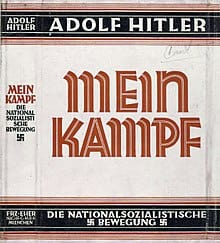
- With relatively few party members, Hitler organised their biggest meeting by far on 24 February 1920 at the Hofbrauhaus am Platzl. The DAP was also renamed the National Socialist German Workers’ Party.
DAP to NSDAP
- Compared to the other political parties, such as the Social Democratic Party (SPD) and the German Communist Party (KPD), the NSDAP was strongly nationalist. In February 1920, the party published its first programme. Written by Hitler, Feder, Drexler and Eckart, it was known as the 25-point Programme.
English translation of the manifesto
- We want all Germans to live in one ‘Germany’.
- We want Germany to be treated the same as other nations, and we want the peace treaties of Versailles to be cancelled.
- We want land and territory (colonies) to feed our people and to settle our surplus population.
- Only Germans may be citizens of Germany. Only those of the German race may be members of the nation; their religion does not matter. No Jew may be a citizen.
- Non-citizens may live in Germany, but there will be special laws for foreigners living in Germany.
- Only citizens can vote for parliament and councils, or vote on laws. Everyone who works for the German government, a state government or even a small village must be a citizen of Germany. We will stop giving people jobs because of the political party they are in; only the best people should get a job.
- We think that the government's first job is to make sure every citizen has a job and enough to eat. If the government cannot do this, people who are not citizens should be made to leave Germany.
- No one who is not of a German race should be allowed to live in Germany. We want anyone who is not of a German race to start living in Germany after 2 August 1914 to leave the country.
- All citizens shall have equal rights and duties.
- Every citizen should have a job. Their work should not be selfish, but help everyone. Therefore we demand:
- The abolition of incomes unearned by work. The breaking of the slavery of interest.
- So many people die or lose their property in a war; it is wrong for other people to make money from the war. Anyone who made money from the war should have all that money taken away.
- We want all very big corporations to be owned by the government.
- Big industrial companies should share their profits with the workers.
- We want old age pensions to be increased.
- We want to create a healthy middle class, to split up big department stores, and let small traders rent space inside them, and to make state and town governments try to buy from small traders.
- We want to change the way land is owned. We also want a law to take over land if the country needs it, without the government having to pay for it; to abolish ground rent; and to prohibit land speculation (buying land just to sell to someone else for more money).
- Crimes against the common interest must be punished with death.
- We want the Roman law system changed to the German common law system.
- We want to change the system of schools and education so that every hard-working German can have the chance of higher education. What is taught should concentrate on practical things. Schools should teach civic affairs so that children can become good citizens. If a poor parent cannot afford to pay, the government should pay for education.
- The state must protect health standards by protecting mothers and infants, stopping children from working, making a law for compulsory gymnastics and sports, and supporting sports clubs for young men.
- We want to get rid of the old army and replace it with a people’s army that would look after the ordinary people, not just the rich officer-class.
- We want the law to stop politicians from being anti-German, and newspapers from writing about them. To make a German national press, we demand: that all editors of, and writers in the German-language newspapers are members of the nation (of a German race); Foreign newspapers need permission from the government. They must not be printed in the German language; Non-Germans cannot own or control German newspapers. Any non-German who does own or control a newspaper will be made to leave Germany, and the newspaper closed down. Newspapers that criticise the country or the government are not allowed. Art and books that support foreign ideas should be banned.
- We want to allow all religions in the state, unless they offend the moral feelings of the German race. The NSDAP is Christian, but does not belong to any denomination. The NSDAP will fight the Jewish self-interest spirit, and believes that our nation will be strongest only if everyone puts the common interest before self-interest.
- We will create a strong central government for the Reich; give parliament control over the entire government and its organisations; form groups based on class and job to carry out the laws in the various German state.
- Other prominent members of the NSDAP included Felix Graf von Bothmer (military), Dietrich Eckart (playwright/publicist), Hans Frank (politician/lawyer), Ernst Röhm (military) and Rudolf Jung (leader of the Bohemian movement).
- By the end of 1920, party membership grew to 2,000. Many were recruited by Hitler and Röhm, either by personal recommendation or because of the former’s oratory skills.
- In July, Hitler threatened to resign from the party under the impression of NSDAP union with the German Socialist Party (DSP). Aware of Hitler’s significance, the committee persuaded his return. Hitler agreed to rejoin the party under the condition of replacing Drexler as party chairman. In the same month, Hitler rejoined the party.
- In 1921, a party militia known as the Sturmabteilung (SA), or Brownshirts, was established. Their main goal was to protect party leaders and attack other political parties.
- On 7 August 1920, the Nazis used the insignia as the party’s official emblem at the Salzburg Congress. The social idea of the movement was represented by the red colour, while white stood for its nationalistic view. The swastika at the centre symbolised the struggle for the victory of the Aryan race.
- In 1920, the NSDAP acquired the newspaper Völkischer Beobachter. Also, around this time, Hermann Göring and Heinrich Himmler joined the party.
- Between 1921 and 1922, party membership grew significantly. On 31 October 1922, Benito Mussolini founded the National Fascist Party in Italy. Like the Nazis, the Fascists supported nationalism and opposed communism and liberalism. Inspired by fascism, Hitler adopted the straight-armed salute like the Romans.
- In 1923, supported by WWI General Erich Ludendorff, NSDAP launched the Beer Hall Putsch in Munich. On 9 November 1923, about 2,000 Nazi supporters marched in the streets of Munich. Hitler, Ludendorff and other Nazi leaders were arrested and tried for treason. On the same day, the NSDAP was banned. However, it continued to exist under the name German Party, or Deutsche Partei (DP), in 1924-1925.
- After being released from prison in December 1924, Hitler refounded the NSDAP on 26 February 1925. In the same year, the SS, or the Schutzstaffel, was created. From being a member of the SS, Himmler became its leader from 1929 until 1945.
- In 1928, Gregor Strasser was promoted to national organisation leader and improved party recruitment and organisation.
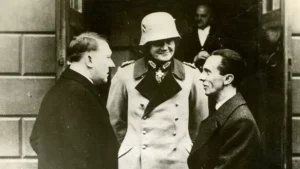
(from left to right) Adolf Hitler, Werner von Blomberg and Joseph Goebbels - By 1929, the new NSDAP had 130,000 members. At this time, the NSDAP followed a strict hierarchical structure. Below Hitler were senior party leaders such as Himmler, Goebbels and Göring. Beneath them were Gauleiters (regional leaders), then Kreisleiter (county leaders), Zellenleiter (cell leaders) and Blockleiter (block leaders).
- When Germany was hit by the Great Depression in 1930, Hitler took advantage of the divide between the Social Democrats and the Communists. He blamed the Bolsheviks and the Jews for the economic crisis.
- As a result, the Nazis won 18% of the votes during the Reichstag elections in September 1930. The NSDAP became the second-largest party in the Reichstag following the SD. The campaign was more effective when Hitler replaced Strasser with Goebbels.
- In 1932, Hitler ran as president against Paul von Hindenburg. With 53% popular votes against Hitler’s 36.8%, Hindenburg was re-elected. In July 1932, the NSDAP became the largest party in the Reichstag, with 37% seats. Chancellor Franz von Papen called another Reichstag election in November 1932. The NSDAP remained to be the largest party, but support declined to 33.1%.
- The result of the election was interpreted by the Nazis as a sign to seize power immediately. To prevent Nazi aggression, Papen urged President Hindenburg to appoint Hitler as chancellor, which happened on 30 January 1933.
- Another official symbol of the Nazis was the German eagle standing atop a wreath of oak leaves bearing a swastika. Also known as the iron eagle, this symbol was called the Parteiadler.
- On 10 October 1945, the NSDAP was formally abolished by the Allied Control Council. Furthermore, denazification in Germany and other German-controlled territories began.

